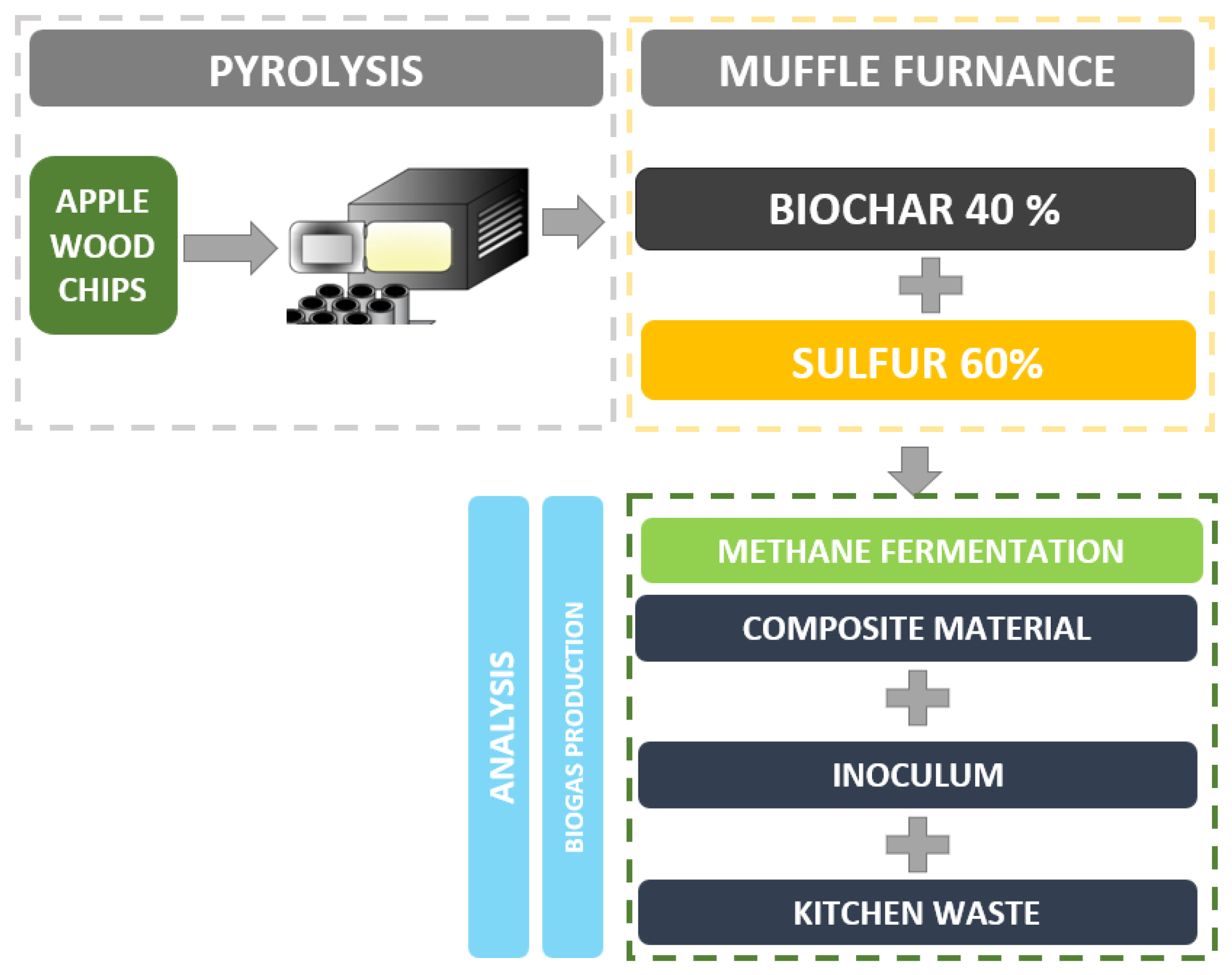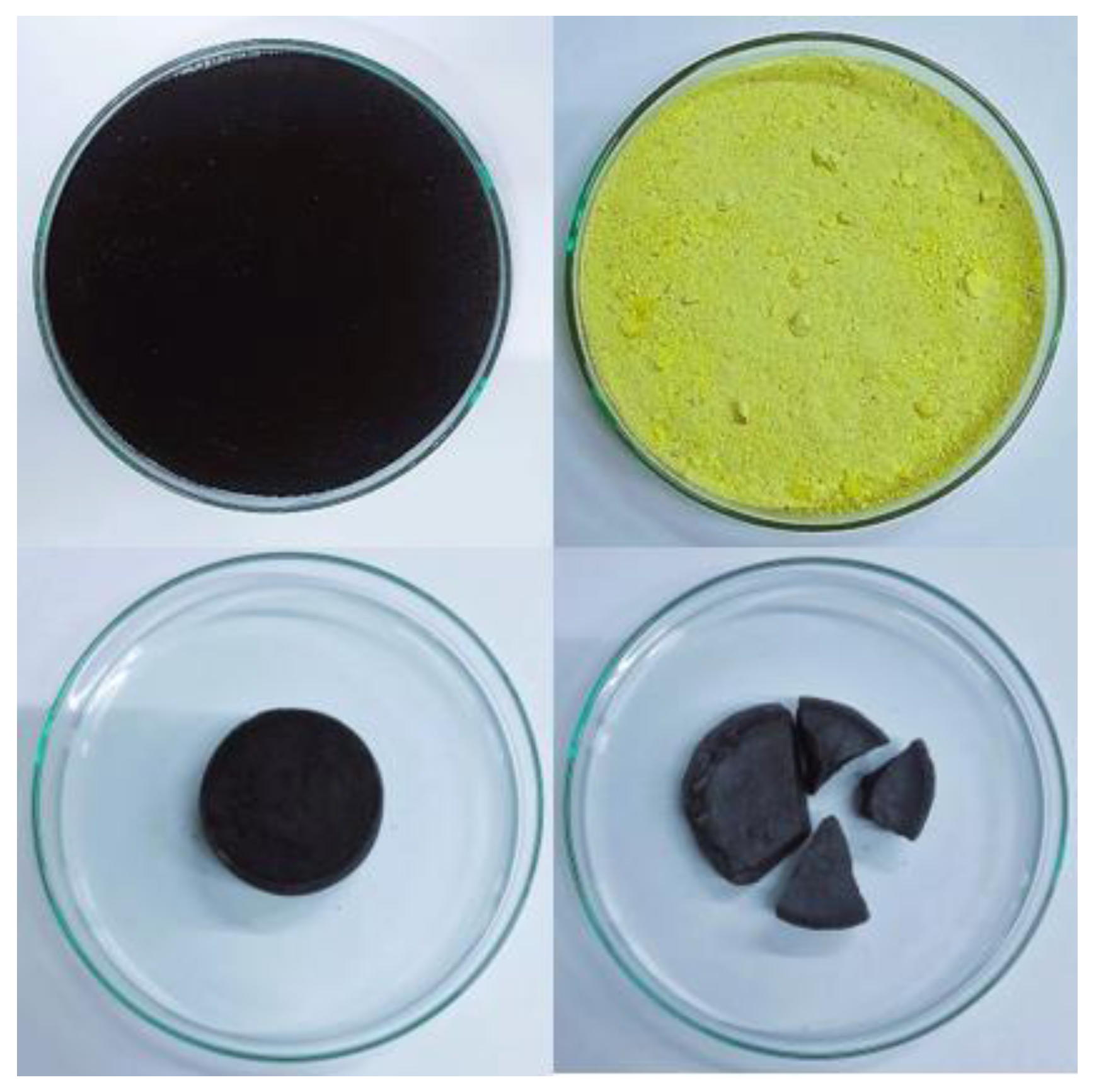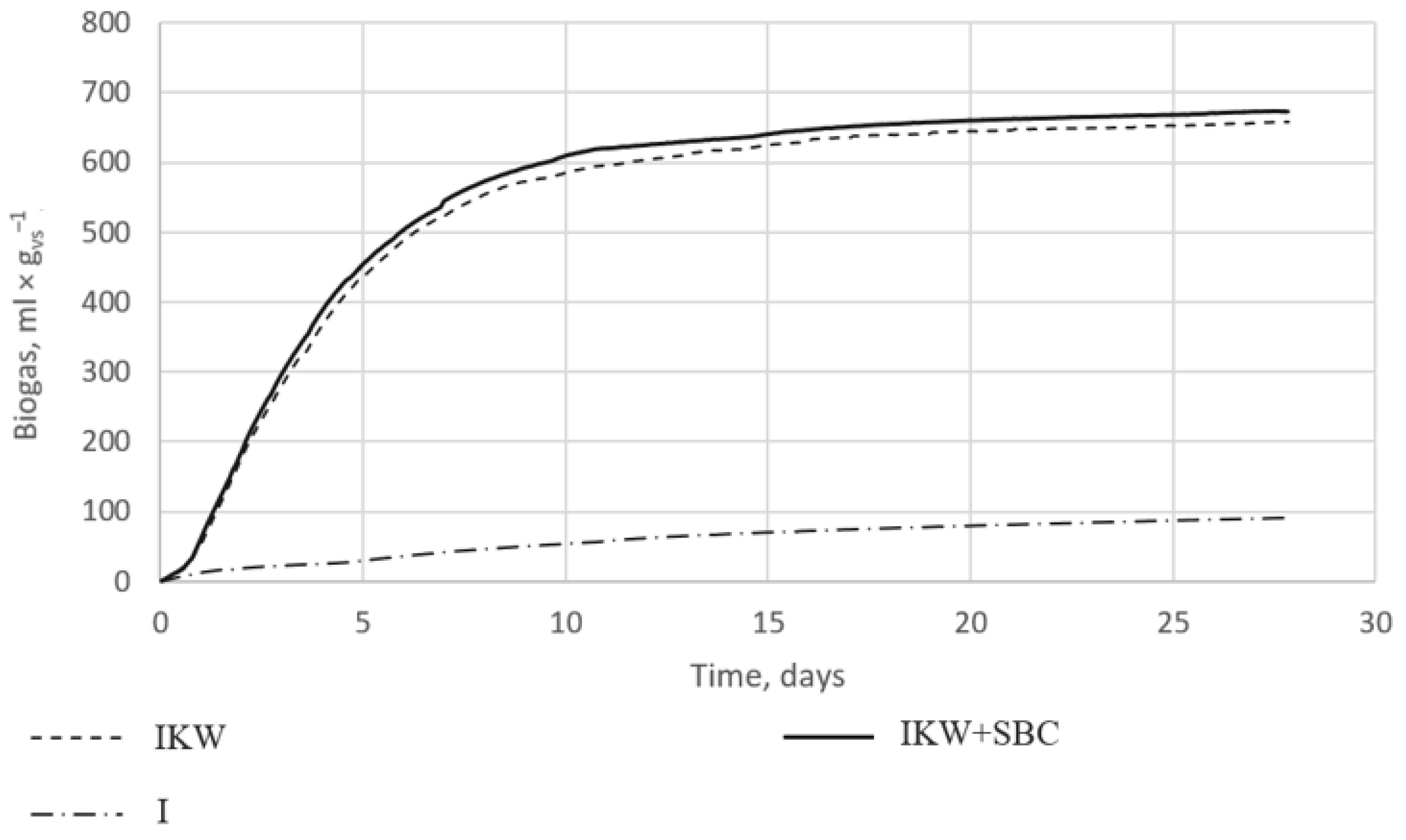Enhanced Production of Biogas Using Biochar–Sulfur Composite in the Methane Fermentation Process
Abstract
:1. Introduction
1.1. Methane Fermentation with Biochar
1.2. Production of Sulfur
1.3. Composite Materials
1.4. Properties of Sulfur
1.5. Aim of the Study
2. Materials and Methods
2.1. Materials
2.1.1. Inoculum
2.1.2. Kitchen Waste
2.1.3. Biochar
2.1.4. Sulfur
2.2. Methods
2.2.1. Production SBC
2.2.2. Anaerobic Digestion
- Bt—biogas volume over time t, mL × gvs−1;
- B0—maximum production of biogas from the substrate, mL × gvs−1;
- K—reaction constant rate, d−1;
- t—process time, days.
- r—biogas production rate, mL × gvs−1 × d−1.
3. Results and Discussion
3.1. Production of SBC
3.2. Anaerobic Digestion
4. Conclusions
Author Contributions
Funding
Institutional Review Board Statement
Informed Consent Statement
Data Availability Statement
Acknowledgments
Conflicts of Interest
References
- Singhvi, M.; Kim, B.S. Current Developments in Lignocellulosic Biomass Conversion into Biofuels Using Nanobiotechology Approach. Energies 2020, 13, 5300. [Google Scholar] [CrossRef]
- Syguła, E.; Koziel, J.A.; Białowiec, A. Proof-of-concept of spent mushrooms compost torrefaction—Studying the process kinetics and the influence of temperature and duration on the calorific value of the produced biocoal. Energies 2019, 12, 60. [Google Scholar] [CrossRef] [Green Version]
- Świechowski, K.; Matyjewicz, B.; Telega, P.; Białowiec, A. The Influence of Low-Temperature Food Waste Biochars on Anaerobic Digestion of Food Waste. Materials 2022, 15, 945. [Google Scholar] [CrossRef] [PubMed]
- Sun, J.; Lian, F.; Liu, Z.; Zhu, L.; Song, Z. Biochars derived from various crop straws: Characterization and Cd(II) removal potential. Ecotoxicol. Environ. Saf. 2014, 106, 226–231. [Google Scholar] [CrossRef] [PubMed]
- Syguła, E.; Świechowski, K.; Hejna, M.; Kunaszyk, I.; Białowiec, A. Municipal solid waste thermal analysis—Pyrolysis kinetics and decomposition reactions. Energies 2021, 14, 510. [Google Scholar] [CrossRef]
- Dudek, M.; Świechowski, K.; Manczarski, P.; Koziel, J.A.; Białowiec, A. The effect of biochar addition on the biogas production kinetics from the anaerobic digestion of brewers’ spent grain. Energies 2019, 12, 1518. [Google Scholar] [CrossRef] [Green Version]
- Wang, F.; Chen, J.; Hong, H.; Wang, A.; Lin, H. Pollutant removal and membrane fouling in an anaerobic submerged membrane bioreactor for real sewage treatment. Water Sci. Technol. 2014, 69, 1712–1719. [Google Scholar] [CrossRef]
- Świechowski, K.; Stępień, P.; Syguła, E.; Koziel, J.A.; Białowiec, A. Lab-scale study of temperature and duration effects on carbonized solid fuels properties produced from municipal solid waste components. Materials 2021, 14, 1191. [Google Scholar] [CrossRef]
- Luo, C.; Lü, F.; Shao, L.; He, P. Application of eco-compatible biochar in anaerobic digestion to relieve acid stress and promote the selective colonization of functional microbes. Water Res. 2015, 68, 710–718. [Google Scholar] [CrossRef]
- Qiu, L.; Deng, Y.F.; Wang, F.; Davaritouchaee, M.; Yao, Y.Q. A review on biochar-mediated anaerobic digestion with enhanced methane recovery. Renew. Sustain. Energy Rev. 2019, 115, 109373. [Google Scholar] [CrossRef]
- Singhvi, M.; Maharjan, A.; Thapa, A.; Jun, H.B.; Soo Kim, B. Nanoparticle-associated single step hydrogen fermentation for the conversion of starch potato waste biomass by thermophilic Parageobacillus thermoglucosidasius. Bioresour. Technol. 2021, 337, 125490. [Google Scholar] [CrossRef] [PubMed]
- Ruszel, M. Rola surowców energetycznych w procesie produkcji energii elektrycznej w UE do 2050 roku Wprowadzenie. Energy Policy J. 2017, 20, 5–16. [Google Scholar]
- Wilson, L.; Orr, J.S.S.D. Geochemistry of Sulfur in Coal; ACS Publications: Washington, DC, USA, 1990; pp. 30–52. [Google Scholar] [CrossRef]
- Vlahovic, M.M.; Martinovic, S.P.; Boljanac, T.D.; Jovanic, P.B.; Volkov-Husovic, T.D. Durability of sulfur concrete in various aggressive environments. Constr. Build. Mater. 2011, 25, 3926–3934. [Google Scholar] [CrossRef]
- Yang, Z.; Peng, H.; Wang, W.; Liu, T. Fundamental Characterization of SBS-Modified Asphalt Mixed with Sulfur. J. Appl. Polym. Sci. 2010, 116, 2658–2667. [Google Scholar] [CrossRef]
- McBee, W.C.; Sullivan, T.A.; Jong, B.W. Sulfapave: Densifiable Sulfur Concrete Materials for Corrosive Environments; US Department of the Interior, Bureau of Mines: Washington, DC, USA, 1984.
- Błaszczyński, T.; Król, M. Ekobetony geopolimerowe. Mater. Bud. 2013, 11, 23–26. [Google Scholar]
- Gulzar, M.A.; Rahim, A.; Ali, B.; Khan, A.H. An investigation on recycling potential of sulfur concrete. J. Build. Eng. 2021, 38, 102175. [Google Scholar] [CrossRef]
- Tokarski, D. Naprawy Zabytkowych Murów Warstwami Uzupełniającymi z Dodatkiem Biowęgla; University of Technology: Białystok: Białystok, Poland, 2021; ISBN 9788366391604. [Google Scholar]
- Fediuk, R.S.; Yevdokimova, Y.G.; Smoliakov, A.K.; Stoyushko, N.Y.; Lesovik, V.S. Use of geonics scientific positions for designing of building composites for protective (fortification) structures. IOP Conf. Ser. Mater. Sci. Eng. 2017, 221, 012011. [Google Scholar] [CrossRef]
- Sugawara, A. Thermal conductivity of sulfur accompanying crystal transition and phase change. J. Appl. Phys. 1965, 36, 2375–2377. [Google Scholar] [CrossRef]
- Yan, R.; Ng, Y.L.; Chen, X.G.; Geng, A.L.; Gould, W.D.; Duan, H.Q.; Liang, D.T.; Koe, L.C.C. Batch experiment on H2S degradation by bacteria immobilised on activated carbons. Water Sci. Technol. 2004, 50, 299–308. [Google Scholar] [CrossRef]
- Świechowski, K.; Syguła, E.; Koziel, J.A.; Stępień, P.; Kugler, S.; Manczarski, P.; Białowiec, A. Low-Temperature Pyrolysis of Municipal Solid Waste Components and Refuse-Derived Fuel—Process Efficiency and Fuel Properties of Carbonized Solid Fuel. Data 2020, 5, 48. [Google Scholar] [CrossRef]
- Mumme, J.; Srocke, F.; Heeg, K.; Werner, M. Use of biochars in anaerobic digestion. Bioresour. Technol. 2014, 164, 189–197. [Google Scholar] [CrossRef] [PubMed]
- Sunyoto, N.M.S.; Zhu, M.; Zhang, Z.; Zhang, D. Effect of biochar addition on hydrogen and methane production in two-phase anaerobic digestion of aqueous carbohydrates food waste. Bioresour. Technol. 2016, 219, 29–36. [Google Scholar] [CrossRef] [PubMed]
- Pererva, Y.; Miller, C.D.; Sims, R.C. Existing Empirical Kinetic Models in Biochemical Methane Potential (BMP) Testing, Their Selection and Numerical Solution. Water 2020, 12, 1831. [Google Scholar] [CrossRef]



| Reactor ID | Inoculum, g | Kitchen Waste, g | SBC, g |
|---|---|---|---|
| I | 200.00 | - | - |
| I | 200.00 | - | - |
| IKW | 200.00 | 2.500 | - |
| IKW | 200.00 | 2.502 | - |
| IKW + SBC (I) | 200.00 | 2.510 | 0.2509 |
| IKW+ SBC (II) | 200.00 | 2.509 | 0.2506 |
| Reactor Content | Parameter | Values | Unit |
|---|---|---|---|
| I | k | 0.076 | d−1 |
| B0 | 102.82 | mL × gvs−1 | |
| r | 7.81 | mL × gvs−1 × d−1 | |
| R2 | 0.99 | - | |
| IKW | k | 0.205 | d−1 |
| B0 | 658.64 | mL × gvs−1 | |
| r | 135.02 | mL × gvs−1 × d−1 | |
| R2 | 0.98 | - | |
| IKW_SBC | k | 0.214 | d−1 |
| B0 | 674.60 | mL × gvs−1 | |
| r | 143.36 | mL × gvs−1 × d−1 | |
| R2 | 0.98 | - |
Publisher’s Note: MDPI stays neutral with regard to jurisdictional claims in published maps and institutional affiliations. |
© 2022 by the authors. Licensee MDPI, Basel, Switzerland. This article is an open access article distributed under the terms and conditions of the Creative Commons Attribution (CC BY) license (https://creativecommons.org/licenses/by/4.0/).
Share and Cite
Syguła, E.; Gałęzowska, M.; Białowiec, A. Enhanced Production of Biogas Using Biochar–Sulfur Composite in the Methane Fermentation Process. Materials 2022, 15, 4517. https://doi.org/10.3390/ma15134517
Syguła E, Gałęzowska M, Białowiec A. Enhanced Production of Biogas Using Biochar–Sulfur Composite in the Methane Fermentation Process. Materials. 2022; 15(13):4517. https://doi.org/10.3390/ma15134517
Chicago/Turabian StyleSyguła, Ewa, Michalina Gałęzowska, and Andrzej Białowiec. 2022. "Enhanced Production of Biogas Using Biochar–Sulfur Composite in the Methane Fermentation Process" Materials 15, no. 13: 4517. https://doi.org/10.3390/ma15134517









